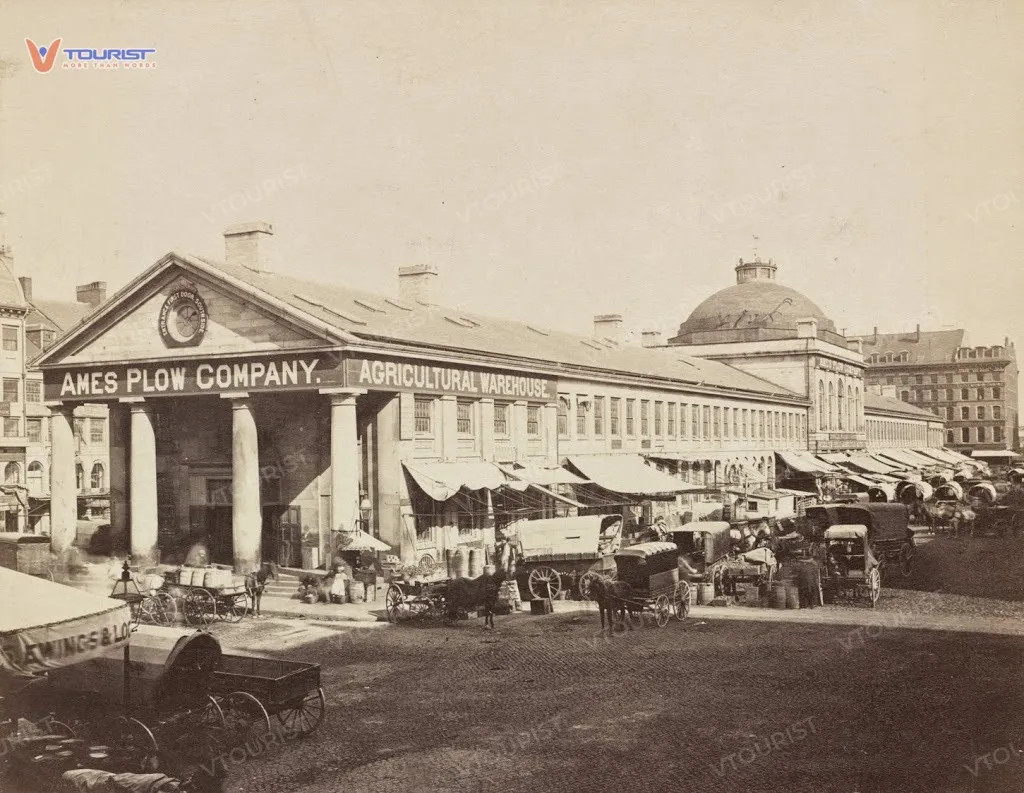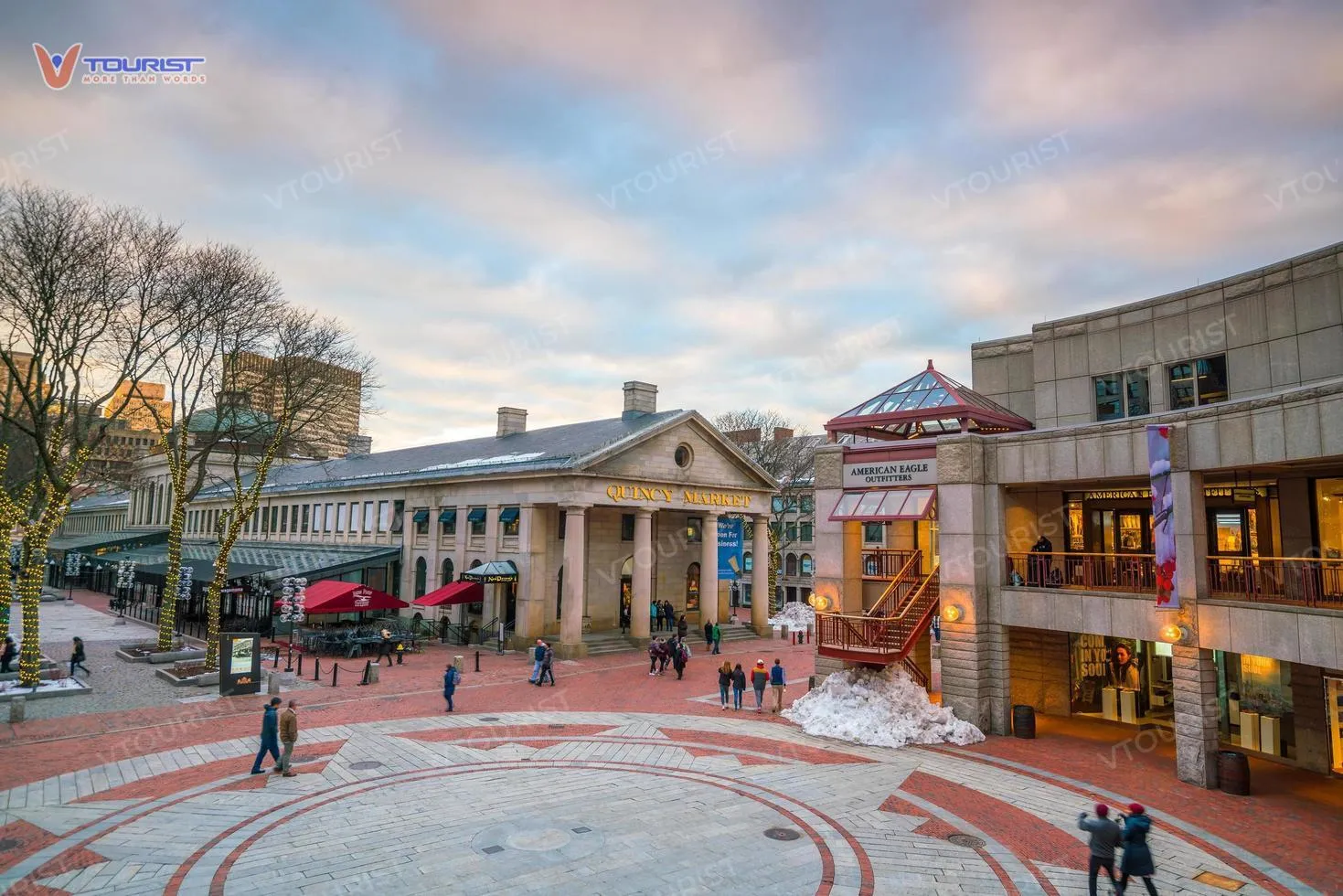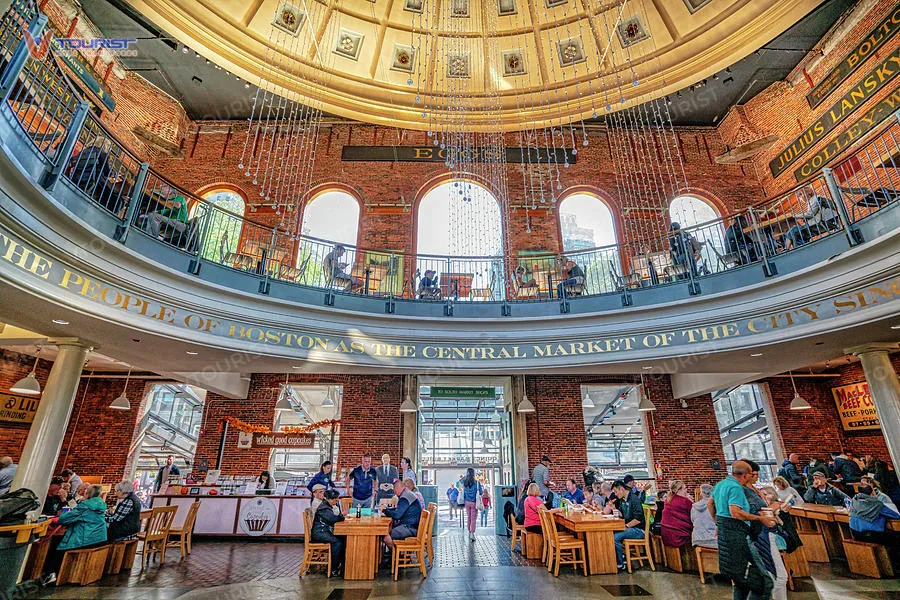Massachusetts, renowned for its picturesque beaches and historical landmarks, harbors a hidden gem in the heart of Boston – Quincy Market. While not a floating market in the literal sense on water, Quincy Market offers a unique and vibrant experience akin to an “on-land floating market,” a confluence of culture, cuisine, and history. Visiting Quincy Market, you’ll immerse yourself in a lively atmosphere, explore impressive architecture, and savor enticing local specialties.
Explore Quincy Market – Boston’s Enduring Symbol of Commerce
Prime Location of Quincy Market
Quincy Market is situated in the heart of downtown Boston, Massachusetts, USA, adjacent to the famed Faneuil Hall. This central location makes Quincy Market an unmissable destination for any visitor to Boston. With nearly 200 years of history, the market is not merely a shopping venue but an integral part of Boston’s history and culture. The area surrounding the market is always bustling with tourists and locals, creating a vibrant and energetic atmosphere.
Historical Significance of Quincy Market

Quincy Market is more than just a typical marketplace; it’s a historical icon of Boston. Constructed in 1826, the market embodies the story of the city’s commercial and urban development. In the 19th century, Boston was experiencing rapid growth, and the existing Faneuil Hall Market area could no longer meet the increasing trade demands. Thus, the Quincy Market project was conceived to expand commercial space and cater to the needs of a burgeoning city.
The talented architect Alexander Parris was entrusted with designing Quincy Market. He created a unique architectural marvel, blending neoclassical style with modern elements of the 19th century. The market’s location is also remarkable, as part of Boston’s harbor was reclaimed to create space for it. This was a bold and innovative decision, reflecting the city government’s forward-thinking approach to urban planning and development. The establishment of Quincy Market not only resolved the issue of commercial space but also contributed to urban renewal, expanding and redeveloping surrounding streets, creating a bustling and modern city center.
Initially, Quincy Market primarily traded in agricultural products and fresh food. The market stalls offered a wide array of goods, from fresh fruits and vegetables, meats and fish to processed products like eggs, cheese, and bread. It quickly became a vital food supply center for Boston residents and neighboring areas. Archaeological discoveries in the late 1970s during market expansion uncovered evidence of livestock slaughtering within the market, demonstrating Quincy Market’s crucial role in the city’s food supply chain.
Beyond the market’s interior, the exterior area was equally lively with street vendors and performances, creating a bustling and captivating traditional market atmosphere.
Unique Architecture of Quincy Market

The architecture of Quincy Market is a harmonious fusion of classical beauty and modern convenience. The main market building is an impressive 163 meters long, with a vast area of 2,500 square meters. The primary construction materials are granite and glass, creating a solid, imposing appearance while ensuring ventilation and natural light. Quincy Market was a pioneer in large-scale granite and glass usage in the 19th century, showcasing architectural innovation of the time.
The east and west facades of the market are designed in the classical Roman style, featuring majestic triangular pediments and sturdy Doric columns. These details not only provide aesthetic appeal but also express reverence for ancient architecture. Conversely, the building’s sides exhibit a more modern style with rows of rectangular windows, creating an intriguing and unique contrast.
Inside the market, a system of cast iron columns and iron tie rods is ingeniously used, creating a spacious, airy, and flexible environment. The roof is designed with eight evenly spaced chimneys and a prominent copper dome at the center. The dome is not just an architectural highlight but also serves to shelter the communal seating area and main entrances, enhancing visitor convenience.
Quincy Market also includes two auxiliary buildings, North Market and South Market, constructed from brick and granite on a smaller scale, each building being only one and a half stories. Despite undergoing numerous renovations, these buildings have retained their original architectural character and are under consideration for designation as Boston Landmarks, contributing to the preservation of the city’s valuable architectural heritage.
The entire Quincy Market complex was recognized as a Boston Landmark in 1996 and listed on the National Register of Historic Places in 1966. Quincy Market’s architecture is not just a construction project but a work of art, reflecting Boston’s development and a significant part of the city’s cultural and historical legacy.
Shopping and Culinary Paradise at Quincy Market

Visiting Quincy Market, tourists not only admire the unique architecture but also indulge in shopping and diverse culinary delights. The market is a hub for countless stalls and shops selling a wide variety of items, from souvenirs, jewelry, clothing, and leather goods to handicrafts and local specialties.
Quincy Market’s food court is a rich world with countless options from around the globe. Visitors can find signature dishes from various cultures such as Thai, Indian, Chinese, Italian, and American. In particular, the Clam Chowder – a creamy clam soup, a renowned Boston specialty – is a must-try. Clam Chowder at Quincy Market is made from fresh ingredients, with a rich, creamy, and savory flavor that is sure to satisfy every palate.
Moreover, Quincy Market is a souvenir paradise. Visitors can find unique gifts, imbued with the Boston and New England spirit, such as wooden, glass, and leather handicrafts. Exquisitely carved glass products are among the most popular items at the market. Jewelry stores also attract many tourists with sophisticated and elegant designs in gold, silver, and gemstones.
If you love fashion, you can also find clothing and leather goods stores with diverse styles, from classic to modern. Leather products like handbags, wallets, and belts at Quincy Market are renowned for their quality and durability.
Beyond shopping, Quincy Market is also a vibrant cultural and artistic space. Visitors may encounter street performers showcasing music, magic, and art installations, providing enjoyable entertainment moments.
Connecting History and Culture at Quincy Market

Quincy Market is not just a commercial destination but also a significant historical landmark of Boston. Located just west of the market is Faneuil Hall, known as the “Cradle of Liberty.” Faneuil Hall was the venue for crucial historical meetings during Bostonians’ struggle for independence against British rule. Today, Faneuil Hall remains a beautiful architectural structure with red brick walls and a distinctive white octagonal cupola, attracting numerous visitors to explore and learn about the city’s heroic history.
The combination of Quincy Market and Faneuil Hall creates a unique historical, cultural, and commercial complex. Visitors here not only shop and dine but also immerse themselves in a historical atmosphere, feel the vibrant pulse of Boston, and discover distinctive cultural values.
Experience Quincy Market with Du lịch Khắp Thế Gian
Quincy Market is an ideal destination to fully experience Boston’s culture, history, and cuisine. For a perfect journey exploring Quincy Market and Boston, join Du lịch Khắp Thế Gian (Travel Around The World). We offer diverse and professionally designed US tours, helping travelers discover the most captivating destinations, including Quincy Market and the Faneuil Hall area.
With Du lịch Khắp Thế Gian, you will:
- Visit Quincy Market and Faneuil Hall in detail and depth, understanding the history, architecture, and culture of these locations.
- Savor distinctive cuisine at Quincy Market with guidance from local guides.
- Explore other famous destinations in Boston and Massachusetts.
- Enjoy high-quality travel services, ensuring comfort and convenience throughout your journey.
Quincy Market is not just a market, but a symbol of Boston, where history, culture, and commerce intersect. Come and experience the uniqueness of this “on-land floating market” to feel the vibrant rhythm of life and discover the fascinating things Boston offers. Contact Du lịch Khắp Thế Gian today to plan your memorable trip!